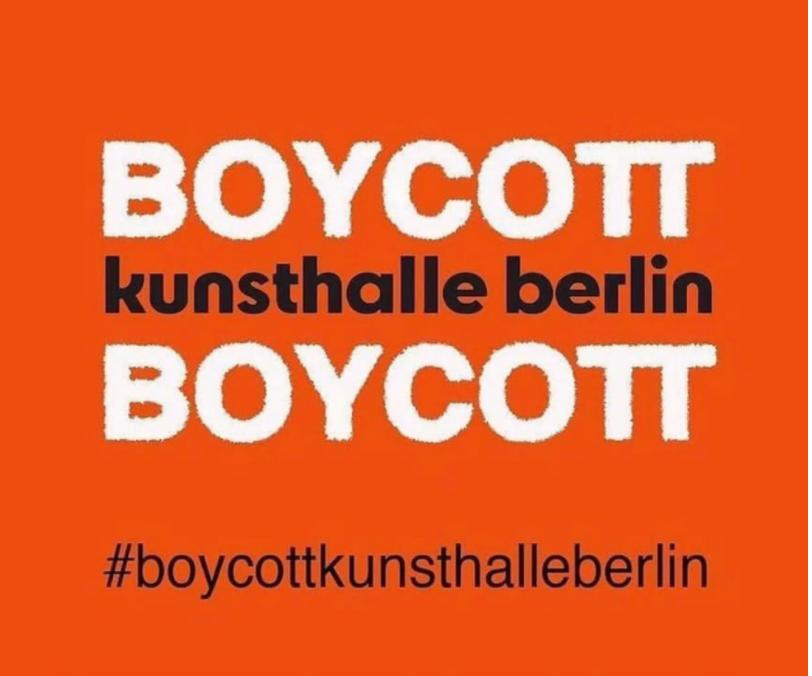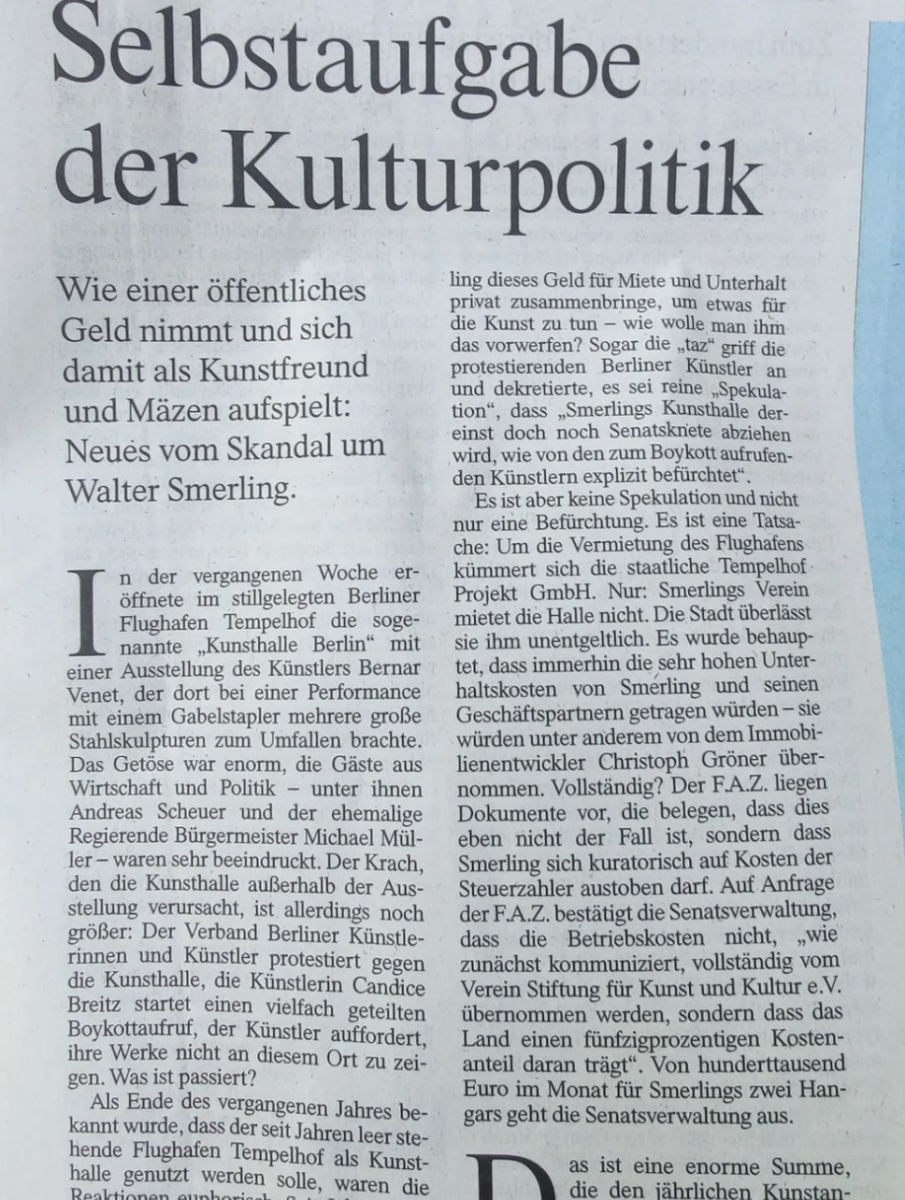Why boycott the ‘Kunsthalle Berlin’? - an open letter
Why boycott the ‘Kunsthalle Berlin’? - an open letter

If you’ve been sitting on the fence when it comes to whether to boycott the new ‘Kunsthalle Berlin’ or not (I personally prefer to call it the ‘Kunsthalle Smerling’), you may find Niklas Maak’s article in yesterday’s FAZ compelling (‘Berlin zahlt auch noch drauf,’ 05.02.22). Maak confirms, unequivocally, what boycotters have been saying all along:
We (the taxpayers of Berlin), without any warning or consultation, have been thrown into a tawdry 50%-50% partnership with Christoph Gröner, a man whose wealth is derived from his activities as one of the most callous and aggressive engineers of gentrification in this city (and far beyond). In partnership with the extravagantly wealthy Gröner, we're covering the exorbitant running costs of a new private institution that is deceptively masquerading as a public institution, having been given the freedom—by city politicians—to occupy one of our most treasured public spaces, for zero rent (Flughafen Tempelhof). The man behind this coup has fraudulently christened his private institution, ‘Kunsthalle Berlin,’ a move which is—almost too obviously to state—good for business:
The director of the private institution is self-appointed: his name is Walter Smerling. The chief curator of the private institution is self-appointed: his name is Walter Smerling. The chief of programming of the private institution is self-appointed: his name is Walter Smerling. Which would all be good and dandy if those of us who don’t support such shenanigans had just been left out of this self-aggrandising operation.
The question is, why the hell are we paying for this charade? Why are we willing to go along with funding an operation that will primarily serve to inflate the value of Venet’s work for the ultimate financial benefit of three men who are most certainly wealthy enough to pay their own electricity bills: Walter Smerling, Johann König and Bernar Venet. Why haven't our cultural politicians—Klaus Lederer most prominent among them—been more vehement in their objections to this farce? Why have they stood by in silence—or, far worse, actively assisted Smerling—as he casually marched into Berlin and declared himself Lord of the Kunsthalle (with a slew of the most despicable and corrupt specimens of the white male variety cheering him on publicly and enthusiastically: Vladimir Putin, Andreas Scheuer, Armin Laschet, Lars Windhorst, Gerhard Schröder, Christoph Gröner)? Is this really the cabal of interests that we can trust to shape and steer a new Kunsthalle in Berlin? Is this really the cabal of interests that we want to subsidise with our tax revenue?
Now Smerling says that he wants ‘to talk.’ And predictably, many journalists are lauding him for being so magnanimously open to ‘talking with artists and stakeholders.’ After shitting on due process and public consultation to self-anoint himself King of the Kunsthalle, powered by the fan-boy zeal of Mayor Müller and a casual shrug of the shoulders from our cultural senator, Klaus Lederer. After appropriating public space and public funding that should rightly have been allocated via broad-reaching consultation with experts in the field of art and culture (to determine what would be in the best interests of the art community at large). You got it—now Smerling is ready 'to talk.’ His underlings are currently reaching out to journalists and institutional leaders to draw them into the stinking rot:
The way I see it—and this is my personal opinion only—there really are only two choices at this point. Either you can jump into bed with Smerling and his squad of squalid boyfriends in one way or another (which would include becoming part of the public audience that Smerling is seeking to generate for his cynical enterprise). Or you can #BoycottKunsthalleBerlin

Read Niklas Maak’s article, ‘Berlin zahlt auch noch drauf' (it’s behind a paywall, unfortunately), as well as the article by Maak that preceded it about a week ago (titled ‘Das System Smerling,’ also published in the FAZ). Read the article by Saskia Trebing in Monopol Magazine. Arrive at your own conclusions. And should you decide that you’d rather not align yourself with this sordid situation, consider joining us and posting one of our ugly orange squares—or an ugly orange square of your own making—on your timeline, to send a signal that we are many.
Maak’s excellent article in the FAZ oversimplifies some basic facts, which is not a big deal in light of the larger issues that are at stake, but it’s worth clarifying a couple of points:
Firstly, Maak gives me far too much credit for the boycott:
#BoycottKunsthalleBerlin is a loosely-organised, spontaneous, decentralised expression of the anger of a wide range of people who care about the future of art and culture in Berlin. It came into being due to the frustration that has been simmering in this city since Smerling’s last Tempelhof escapade, ‘Diversity United.' Contrary to Maak's article, the call to boycott is neither one that is addressed to artists only, nor one that seeks solidarity from artists only. Rather, the boycott seeks to bring together all who regard the Kunsthalle Smerling as an ugly slap in the face to the city of Berlin.
Leading curators, museum directors and institutional voices have chosen to stand in solidarity with the many artists who’ve chosen to boycott, as have a broad network of non-commercial project spaces. A significant number of Berlin galleries are following and supporting the boycott too. Yup, even they get it—that should be an indicator of the depths of the anger and frustration that Smerling has catalysed. Those of us who are boycotting are grateful to have the support of all of these constituencies, knowing that operations like the Kunsthalle Smerling are as damaging to the delicate ecosystem in which public museums and art institutions must struggle to survive, as they are to the community of Berlin artists. Thank you, Bettina Steinbrügge, Gabriele Horn, Krist Gruijthuijsen, Anselm Franke, Inke Arns, Janneke de Vries, Bonaventure Soh Bejeng Ndikung, Övül Ö. Durmusoglu, Hans D. Christ, Didem Yazıcı, Kathrin Becker, María Inés Plaza, Defne Ayas and Alexander Koch, to name but a few, for being willing to stick your necks out publicly to express support for the boycott. To those who have been supportively ‘liking' boycott posts, this may be the moment to consider a bolder gesture of support for the boycott, one of your own choosing:
“Joining the boycott would mean that you elect to avoid visiting the ‘Kunsthalle Berlin,' exhibiting at the ‘Kunsthalle Berlin,’ or otherwise patronising/supporting a highly dubious operation that can only serve to further erode the culture of the city of Berlin.”
Finally, we all like to know who we’re partnering with, especially when we’ve been thrown into a partnership without any consultation whatsoever. Watch the first few minutes of the documentary, ‘Ungleichland,’ to get a taste of what Christoph Gröner stands for (he is, after all, our partner in paying the bills at the Kunsthalle, the sole private funder of Smerling’s current gambit): https://www.youtube.com/watch?v=2Y2WxM2Srlc
Meanwhile, one can’t help but wonder what percentage of the income that Johann König (Venet’s dealer) will be generating for himself (at our expense), will eventually flow back into public coffers. Without having to invest any capital of his own, König is conveniently placed to cash in on the inevitable boost to Venet’s market that the current exhibition at the sogennante ‘Kunsthalle Berlin' will facilitate, via the cynical extraction of public funding by his new best friend, Walter Smerling. Whether you like it or not, friends, if you live in this city and pay your taxes diligently, you are now partially working to enrich Johann König. Please understand that it’s not the fact that König is cashing in on an institutional exhibition that perturbs me. That’s what dealers do (we all know there's a direct correlation between the visibility of an artist’s work in public institutions and the income that the work can generate for the artist and dealer as a result—that is a worthy conversation for another day).
What’s different, in this particular instance, is that Smerling has erected a private institution that is being funded—without an appropriate level of consultation, without the appropriate institutional and decision-making structures having been put in place—with our money, with public money. In other words, König will neatly reap the benefits of what can best be described as a highly cynical capturing of public resources by private interests. Smerling says the next show at the Kunsthalle will focus on digital and NFT-based art practice which, by curious coincidence, aligns exactly with König’s current thrust as a dealer. I’m sure I’m not the only one who is waiting with bated breath to see how Smerling will go about putting Part Two together.
And finally, fuck it, as much as there are many people out there who don’t want to hear it, I will not abstain from saying, yet again, if only to maintain my reputation as one of the ball-breaking feminists that some of you love to despise:
Every single individual who has enabled, orchestrated or is benefitting significantly from this hot mess of a Kunsthalle in one way or another, is a white man—every single individual who is a prominent player in this dirty fiasco. Are you down with that? Is that working for you in 2022? Because last time I checked, the art community of Berlin was not composed exclusively of white men. Last time I took a look, in fact, Berlin was not a city inhabited solely by white taxpayers.
I know that facts like these can be uncomfortable, especially if you subscribe to the cult of meritocracy, or believe that we are all playing on a level playing field. Hell, I know that there are even a handful of prominent women and feminists who are willing to be instrumentalised in the Smerling System, which can definitely be confusing. But at the end of the day, is this really who we want to be as a city of artists?
Kudos to the growing number of white men out there who understand that discussions around the violent disparities that govern our daily lives—including in the realm of art—need to be and ought to be challenged. Kudos to the growing number of white men who understand that the labour of challenging and deconstructing patriarchal hegemony and white supremacy is work that will ultimately benefit us all. Kudos to the growing number of white men who don’t run into the corner with their tails between their legs crying, ’not all white men,’ every time a feminist tries to open up conversations of this nature, because while they may still be in the minority, such white men understand that critical discourse addressing patriarchal hegemony is not a personal ‘attack’ on them, but an effort to imagine what it might mean to live in a world in which resources, opportunities and decision-making are distributed more equitably among all.
To be clear, the opinions expressed in this letter are my own, rather than being representative of the sentiments and opinions of all boycotters. While boycotters of the Kunsthalle have been sharing a hashtag (#BoycottKunsthalleBerlin) and key points of protest, it is important to acknowledge that there are a number of complex reasons to boycott this fraudulent institution. Those of us who are boycotting wish to hear as many people as possible voicing their opinions, as and how they wish. I ask journalists who are following and quoting my words in their reportage of this unfolding drama, to avoid framing my personal opinions as being representative of the views of all who have chosen to:
#BoycottKunsthalleBerlin
#BoycottKunsthalleSmerling
Candice Breitz
Berlin, 5 February 2022